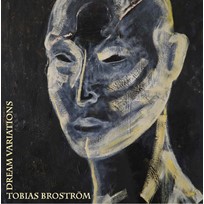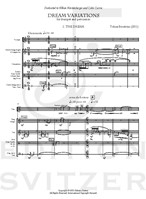
Dream Variations
Composer: Tobias Broström
Instrument: Trumpet and Percussion
Level: Advanced
Published: 2011
Price: €35.00
Item details
-
Description +
-
Duration: 15 min.
Dedicated to Håkan Hardenberger and Colin Currie
-
-
Instrumentation +
-
Trumpet and Percussion
Percussion:
Log Drum
Wood-Block
Cymbal (Suspended)
Dubaci *
Vibraphone
10 Java Gongs (high)
2 Java Gongs (low)
2 Almglocken
Tam-Tam
2 Peking Gongs
*) can be replaced with Metal/Glass Bowl
-
-
About the composer +
-
Tobias Broström was born in 1978 in Helsingborg, Sweden. Following four years of percussion studies at the Malmö Academy of Music, he embarked on the pursuit of a Master’s degree in composition, studying with the Swedish composer Rolf Martinsson and the Italian composer Luca Francesconi.
Broström has composed chamber opera and various chamber music, but during the last years he has mainly focused on orchestral writing in works such as La Danse, Transit Underground, Crimson Skies, Crimson Seas, Kaléidoscope, Violin Concerto, Arena – Percussion Concerto No. 1, Piano Concerto – Belle Epoque, Samsara, Cello Concerto and Lucernaris – Concerto for Trumpet, Live Electronics & Orchestra, which was composed for Håkan Hardenberger. Numerous soloists, conductors, ensembles and orchestras, including, Robin Ticciati, Michael Sanderling, John Storgårds, Anna Larsson, Karen Gomyo, Thomas Søndergård, Andrew Manze, Dima Slobodeniouk, Johannes Gustavsson, Per Tengstrand, Colin Currie, Mats Rondin, Tõnu Kaljuste, Simon Preston, Johan Bridger, Hugo Ticciati, Jaime Martín, BBC Symphony, Detroit Symphony, Dresdner Philharmonie, BBC Philharmonic, Komische Oper Berlin, Symphonieorchester des Bayerischen Rundfunks, Estonian National Orchestra, BBC Scottish Symphony Orchestra, BBC Wales, Gävle SO, Helsingborg SO, Trondheim SO, Malmö SO, Sinfonieorchester St. Gallen, Vogtland Philharmonie, Oviedo SO, NorrlandsOperans SO, Aurora Chamber Orchestra, Brooklyn Rider, Musica Vitae, Third Coast Percussion Quartet, Malleus Incus, Essens:1 and Gageego have performed his works. Tobias’ music have been performed throughout Europe, the USA and Asia.
Between 2006 – 2009 Tobias was Composer-in-Residence with the Gävle Symphony Orchestra under principal conductor Robin Ticciati, resulting in two new orchestral works each year. Two of these, Crimson Seas & Lucernaris were selected by Swedish Radio to represent Sweden in the European Broadcasting Union’s International Rostrum of Composers in 2007 & 2009. In autumn 2008 his Arena – Solo Version was picked out to be performed at the 52nd International Festival of Contemporary Music at the Venice Biennale and his orchestral piece Transit Underground was nominated for best orchestral piece of the year by Swedish Music Publishers’ Association. In 2010 Lucernaris was nominated for best orchestral piece and in 2012 La Danse was nominated.
-
-
Reviews +
-
Review (Percussive Notes, March 2013)
Dedicated to Hakan Hardenberger and Colin Currie, Swedish-born composer Tobias Broström’s three-movement “Dream Variations” has subtitled movements: “The Dream,” “Mirror,” and “Déjà Vu.” The first two movements are each about four minutes in length with the final movement being about three-anda-half minutes. A suggested multiple percussion setup provides the percussionist with the vibraphone as the centerpiece and the remaining instruments surrounding it. Top-flight, professional musicians are necessary on both trumpet and multiple percussion for a successful performance, as the primary ensemble challenge is the coordination of rhythmic figures between the performers and the resulting stylistic mood inferred by the intended, dream-like character.
The multiple percussionist opens the slow, first movement without the trumpet, establishing a pensive, almost halting environment of polyrhythms. A set of long, ringing sounds is created through the timbres of the vibraphone, Java gongs, almglocken, and dubaci (which can be substituted with a glass or metal bowl). The trumpet then enters with a soft melody using a Harmon mute. A slow, deliberate musical dialogue emerges (in 6/8) primarily between the vibraphone and the trumpet, ending as quietly as it began.
The overall difficulty of this initial movement is in the internalization of a steady beat between the two performers. There are numerous quintuple-syncopated rhythms permeating the 4/4 and 6/8 meters in the vibraphone. Similarly, the trumpet part has very fast, yet graceful scalar passages challenging the range (from very low passages immediately followed by D-sharps above the staff).
The second movement again surfaces with the resonant gongs and open vibraphone chords before engaging the trumpet’s graceful, arpeggiated melodic figures with a bucket mute. After a loud, rhythmically articulate middle section (primarily a dialogue with the vibraphone and trumpet), the percussionist concludes this pensive movement softly on gongs, vibraphone, and dubaci. The careful selection of appropriate vibraphone mallets, which must be doubled on the resonant gongs and almglocken, are an absolute necessity to a successful performance. Having full control of the registers as well as rapid dynamic shifts represent significant challenges for even the most seasoned trumpeter.
The final movement is an energetic release from the previous two with a tight stretto between the trumpet (again using a bucket mute) and the vibraphone in 6/8. Hinting at a semblance of traditional tonality, the overall effect of this movement is once again atonal with leaps in the trumpet and underlying open fifths in the vibraphone. Shifting meters from 6/8 to 5/8 and unison rhythmic dialogue lead this composition into a concluding, soft cadence.
Although this three-movement duet is well crafted and certainly complex compositionally (it explores some uncommon timbral combinations), the piece does not lend itself as being musically satisfying—particularly from the listener’s perspective. In essence, “Dream Variations” does not present the overall character of a dreamlike musical trance but rather a tremendously difficult work in its individual parts and equally complicated in its compositional duo interplay. It might be enhanced through creatively (presently unstated and not suggested) dramatic muted stage lighting (such as those percussion/instrumental works of Merrill Ellis in times past). In conclusion, I am hesitant to recommend this extremely difficult and challenging duo for a recital.
—Jim Lambert
-
-
Credits +
-
Front Cover
Oil painting: Claes Eklundh, 2009Claes Eklundh was born in 1944 in Malmo, Sweden. An artist since 1964 he has lived and worked in New York, Rome, Paris, Berlin and Florence. He has exhibited extensively in Europe and North America. He is also a member of the Royal Academy of Arts, Stockholm.
Oil painting: Claes Eklundh, 2009 (www.claeseklundh.se)
Front Cover graphics and layout: Claes Eklundh
Engraving: Tobias Broström/Johan Svitzer
Printed in Copenhagen, Denmark
Copyright © Edition SVITZER
www.editionsvitzer.com
-
